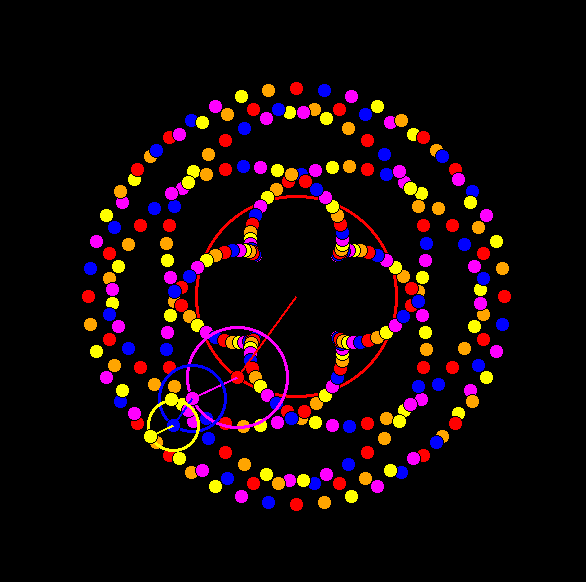
[UPDATE 2021-02-23 : SCB, the Swedish Bureau of Statistics, released their official 2020 death data yesterday. As I predicted, the official data fully concur with the preliminary data of January 18:th that I used in this post. For more details on the official numbers, see this recent post]
2020 was an “interesting” year
2020 – “The Year of Doomsday Modeling”
Scientists and researchers from lots of different disciplines produced lots of theories and mathematical models intended to explain and predict Covid and its impact.
Models that in most cases eventually proved to vastly inflate and overestimate the risks & resulting deaths. It appears that most of these scientists fell in love with their own models & theories, and thus failed to take real world data and reality into account.
Recall all the doomsday models predicting massive deaths already during the “First Wave”…?
E.g. the one by Professor Ferguson of Imperial College, or this one from Belgium, predicting, in line with the predictions of Ferguson’s model, a median of 96000 deaths in Sweden by May 2020 (!), unless strict Lockdowns were immediately put in place….?
2020 was also the year when media declared Sweden as a failed state, the “World’s Cautionary Tale”, predicting massive deaths unless Sweden, like almost everybody else, fully LockedDown.
And 2020 was the year when a lot of economies, public as well as private, businesses and entire industries went bust, because the response governments took to mitigate the pandemic.
During 2020 it also became obvious that True Leadership, of the kind demonstrated e.g. by Churchill during WW2, has pretty much vanished from politics, media as well as from society in general – amplifying fear and panic is the last thing you should do as a Leader during a crisis.
2020 was also the year when China smashed the western world so hard that it will take decades for the west to recover, if indeed ever.
And finally, 2020 was the year when we stopped living due to fear of dying.
So, how deadly did the Pandemic turn out to be ? How many “Excess Deaths” was there…? How proportional were the responses of the various governments ?
The Swedish Outcome
Now, mid January 2021, we have the Swedish result (still preliminary, but perfectly good for overall conclusions): about 98000 deaths for *the full year* – not 96000 by May 2020 (!) , as the models mentioned above (and many others) predicted.
Still, 98000 yearly deaths is clearly more than the normal ~92000 (2019 with it’s 88766 deaths was a true outlier!) of the past few years, so clearly something has been going on 2020. Let’s see if we can figure out what’s been going on, and how much of an outlier 2020 really was…?
Can we trust the preliminary data…?
But first, let’s briefly discuss the realiability of SCB’s preliminary death data: I’ve got a huge number of comments over the past year that :
“you can’t trust the prel. data, there is a huge lag, the numbers will increase a lot by subsequent reporting updates, just wait two more weeks and you’ll see…!”
I’m not sure on what these commentators base their opinions on, but mine are based on the data, as well as on what SCB themselves state about the data lag and it’s expected length and the effect of later updates: SCB.se:
“Statistik för två veckor tillbaka i tiden väntas inte förändras i någon större utsträckning. “
For the non-Swedish speakers, I’m sure Google Translate can help out in making sense of the above quote.
To see that the statement by SCB holds, let’s look at the number of monthly deaths per reporting date, and see how the data changes from one report to next, and then stabilizes, goes flat, when 3 weeks have passed since the first report after month end for that month:
look at the graph below. Take any plot representing a single month e.g. the red plot representing April, and observe how the plot goes basically flat on the third reporting occasion after the month has ended. So, data 3 or more weeks back do not change substantially, exactly as SCB state in their press release above.
If we for each month calculate the difference between deaths the latest reporting date (Jan 18:th), and deaths the third weekly report after end of each individual month, the average monthly update (discounting December, which is most likely have a larger update somewhat later than the “normal” 3 weeks) is 75 deaths.
Now, since December & January are holiday months with both Xmas & New Year, the data reporting lag is somewhat larger for December data than for the other months, but for all practical purposes, for an overall result on whether 2020 was the contemporary equivalent to the Spanish Flu, it doesn’t really matter if the December deaths eventually, when the official 2020 numbers are released, are going to be 100 or even 1000 larger than what was published today.
That possible increase will not change the overall 2020 outcome in any significant way. I’m not after Rocket Science Precision to the n:th decimal in these analyses, and more importantly there are way more significant sources of massive uncertainty in any calculations on Swedish mortality than the possible data lag in SCB’s prel. death data, see below.
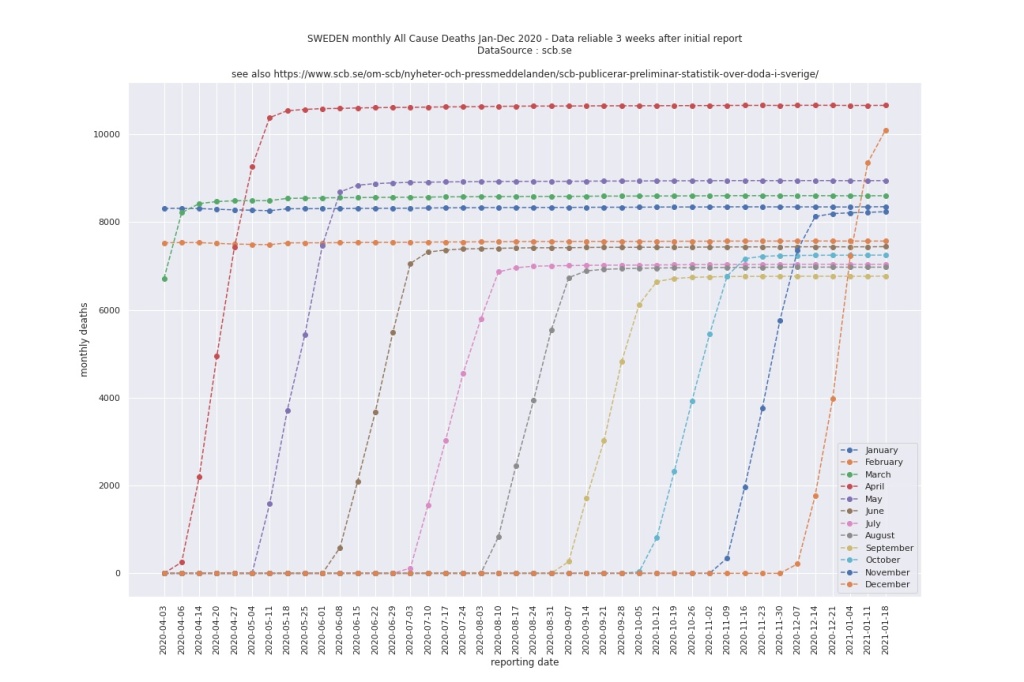
Another, perhaps more significant source of uncertainty regarding the numbers on Swedish mortality stems from political decisions over the past couple of decades, and is described in this (Swedish) article from Göteborgsposten. The basic message is that the true Swedish population size is unknown (!) and could very well be several hundred thousand larger than the official numbers say.
2020 – Highest Number of Deaths since 1918 !
The above headline is typical of most media – alarmistic & fear mongering. And it is true – Technically true, but semantically very misleading. Before going into details about why that headline is misleading, let’s first look at some features of the chart below, showing the monthly number of absolute deaths 1900 – 2020:

There’s several interesting anomalies (‘outliers’) in this data, the most obvious one is 1918, the year of Spanish Flu. But also interesting is 1942/43 – in the middle of WW2 deaths *dropped* substantially…! Maybe since almost all Swedish males were drafted, and thus got well fed and cared for by the military, with strict rules of behavior,lots of fresh air and physical activity, and few opportunities for boozing, partying and other types of mischief..?
Here’s a link to an old SCB document on causes of death 1942.
Other notable things on the chart above is that the overall death trend was going down until 1960’s, after which the trend changed direction, the number of deaths started growing, reaching a plateau in early 1980:ies. Any guesses why…?
While talking about outliers, take a look at 2019 in the colorful graph above – deaths 2019 dropped significantly from recent earlier years. We’ll return to that fact below. And finally, 2020: Yes, it it definitely an outlier in terms of absolute deaths – we will have to go all the way back to 1918 for a year with higher death toll.
Demographics – Population Size Matters
Swedish population grows year by year. The more people, the more deaths. Pretty obvious to all but media, it appears. Therefore, comparing absolute deaths instead of deaths per capita, is simply misleading (accidentally or intentionally).
Unfortunately, it’s not just media that enjoys this kind of “Technically true but Semantically misleading” fear mongering and alarmism – even the Swedish Government Bureau of Statistics, SCB, have several times over the course of the pandemic, e.g. here, released news bulletins where they compare different years in terms of absolute deaths. Simply amazing!
But here, in this blog post, we prefer to present semantically meaningful data; here we care for facts & numbers that can help us understand reality.
So let’s adjust the Swedish death numbers by population – as you can see below, population is continuously growing, and growth is accelerating over the past decades.
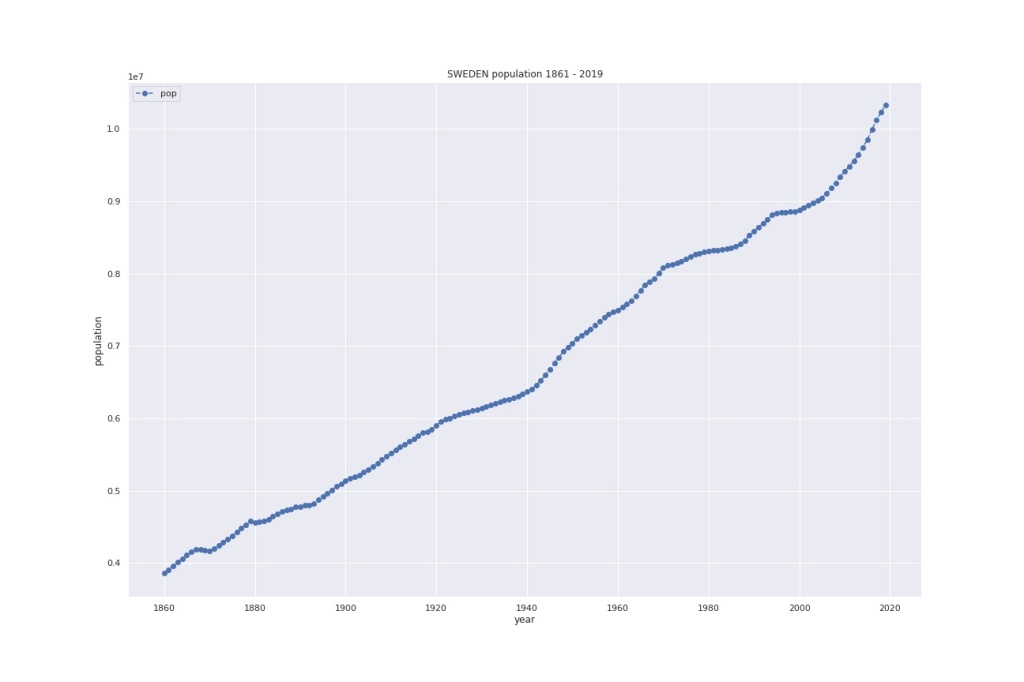
Population Adjusted Deaths (Mortality)
Below mortality (deaths / capita) 2002 – 2020.
Mortality 2020 ended up on par with that of 2012.

Let’s next look at mortality trends over a longer period of time. Below chart presents deaths per capita (“mortality”), based on the same death data as was used a bit earlier in this post. Can you spot the Pandemic…?
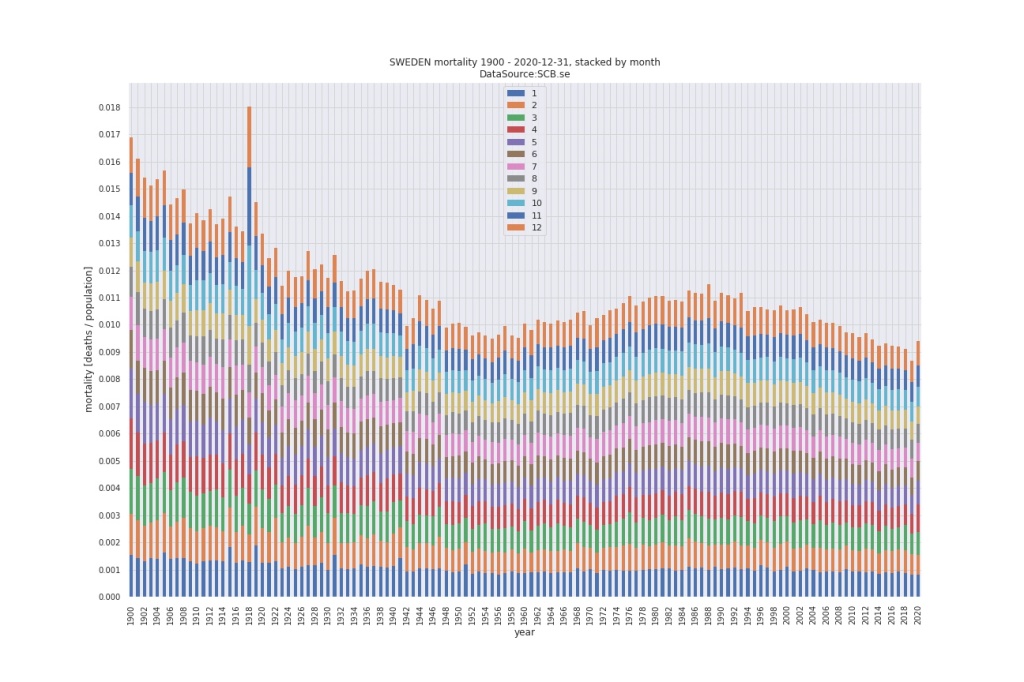
Looking at the full dataset, we can clearly see that there’s a declining overall mortality trend, very likely caused by advances/improvements in population health, medical technology and care,nutrition and other socioeconomic factors.
However, that trend is not monotonic, instead there are clearly visible fluctuations in the data as well as in the trend, e.g. the period of increasing mortality starting around 1960, followed by another declining trend from early 1990 onwards. That latter trend might, or might not, now from 2020 onwards, be broken, e.g. by changes in demographics, as explained in this post from SCB:
“Under 40-talet föddes det väldigt många barn i Sverige vilket gör att vi kan vänta oss att antal döda per år kommer att öka de närmsta tjugo åren.”
Or perhaps we’ll see that 2020 indeed was a real outlier due to the pandemic, and the coming next years will continue the downward mortality trend.
Below a trendline fitted to the full dataset, among other things showing that some caution is always in order in reading trend lines – Math’s & Stat’s both are very unforgiving Gollums in answering your questions – what you ask for is exactly what you get… be sure to ask the right question…. :

According to the trend line above, it looks like the entire period from 1980 onwards has had “excess mortality”, while the period between 1920-1960 has significant mortality deficit – two different periods of “outliers”…
For more info on why care must be taken whenever trying to understand trendlines & various baselines, look no further than here.
For a slightly more relevant trendline, let’s change the start of the dataset to 2010:
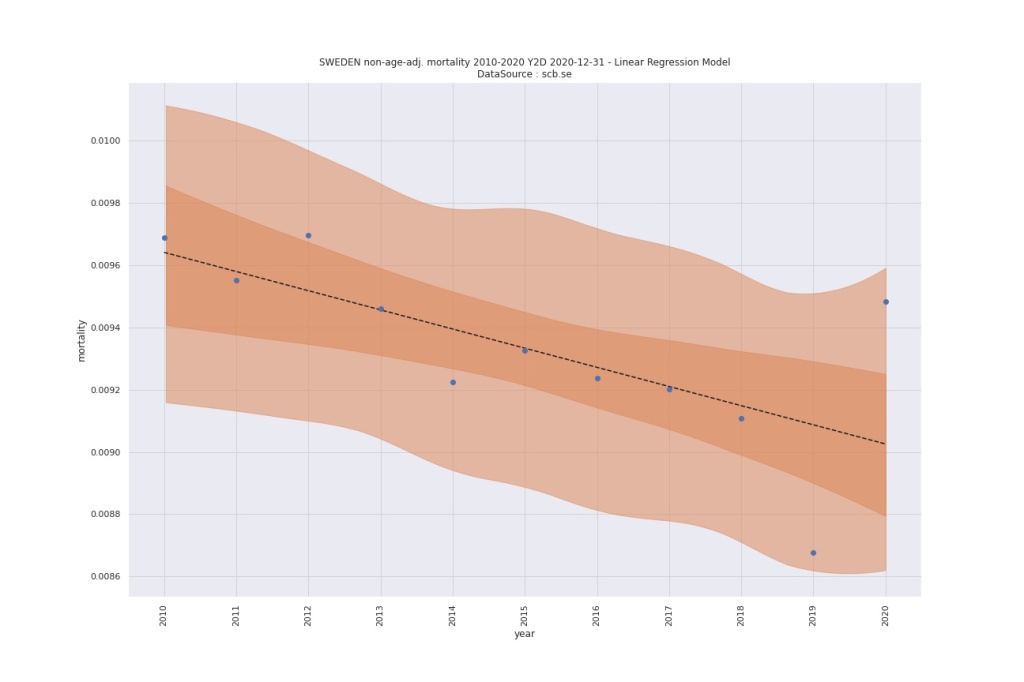
Above we should notice that if we consider 2020 as an outlier, then so should we also consider 2019 as an outlier – mortality 2019 was exceptionally low, and has clearly contributed to the high mortality of 2020 – “Dry Tinder”.
More Demographics – Age Matters
The older the population, the more deaths. Old people tend to die more frequently than young people, in general.
Below graph shows the Y2Y growth factors for different age groups compared to year 1900. Note that the y-scale is not percent, but the actual growth factor.

Below, the proportions of Swedish population by age group and year:

We can also check the age group growth with other baseline years, below six different baselines. It’s clear that the proportion of old people is growing.

So, with a population growing older year-by-year, we need to adjust for age in our mortality calculations to obtain fair mortality numbers to compare. Let’s do so:

Taking population age structure (proportion of old vs young) into account, we arrive at an age adjusted mortality 2020 on par with that of 2013.
We can also look at the same numbers in terms of “Life Expectancy”:

Notice above that 2019 really stands out.
Finally for this section on the importance of population age structure, let’s take a look at the age group specific mortality trends, and comparing them to two different baselines, 2015-2018 and 2015-2019, respectively:

Interesting to notice that for two of the age groups above, the youngest and the oldest, mortality 2020 was below both baselines, while the other two were above.
Even more Demographics – foreign born vs native born
About 1 in 5 people living in Sweden 2019 were foreign born.
There are significant differences in the impact of Covid between native vs foreign born in Sweden. Let’s first look at weekly mortality for both groups:

As we can see from the graph above, from the red and green dashed lines, foreign born typically have much lower mortality rate than native born. The reason most likely being that the average foreign born person in Sweden since a decade or two ago is young, mostly male, i.e. a male migrant/refugee, in his 20-30:ies, and this of course has an impact on mortality of that cohort – young people die less frequently than old people.
Another thing to notice from the graph is that Covid impact hit the foreign born cohort harder, relatively speaking, than the native. How much harder…? Let’s look at the respective weekly mortality growth rates:

Above, we can see that foreign born were hit by Covid substantially harder than native born during the first spring wave: foreign born mortality hit almost factor two of the baseline, while corresponding number for native born – and remember, native born are on average much older – was below 1.4. Also during the Second Wave Nov-Dec, foreign born were hit harder by Covid than native born.
What can explain this striking difference in mortality, where a significantly younger cohort (the foreign born) got hit much harder by the virus than the substantially older and supposedly more frail cohort of native born…? I don’t know, but a reasonable guess could be socioeconomic factors: it’s likely that vastly larger proportion of the native born have much better socioeconomic standing, better jobs, better living conditions, possibility to work from home, travel by own car etc, while the foreign born to higher extent have jobs where physical presence is required. So, my guess is that Zoom is much more frequently the tool of the trade for native born than for the foreign born, and public transport is a much more frequent mean of commute for foreign born than for native born during the pandemic.
Pandemic accounting based on the Gregorian Calender – Regression to the mean
I’m not sure viruses in general care much about calendar’s and years. That is, there’s really no obvious reason for us to measure the impact of a virus based on calendar years.
Calender is a human invention, used by humans to keep track of the periodic patterns of days slowly passing by, governed by our rotation around the sun, and the moon rotating around us.
Let’s next look at what happens if we instead of measuring deaths per year, measure deaths by pairwise years: Let’s look at mortality obtained by looking at pairwise consecutive years:

Now, when combining deaths 2019 – a year with the lowest mortality ever – with deaths 2020, we see that average mortality for 2019/2020 is very much normal. The large number of deaths 2020 is offset by the low number of deaths 2019. Regression to the Mean in action.
Of course, there’s nothing stopping us looking at deaths pairwise years. We can of course combine deaths from more than two consecutive years and look at the mortality obtained:

As mentioned above, I don’t believe viruses care much about calendar years, so let’s also look at seasonal deaths. Below, I’ve defined “season” as going from October 1:st to September last. Unfortunately we’ll have to wait until October 2021 to see the 2020/2021 season results:

Covid Impact – young vs old
So now, let’s stop beating the mortality numbers any further, and instead look at the impact of Covid

Above, we can see that while most age groups (except the really young) get Covid (or at least a positive test), the more severe consequences occur among the elderly: in particular, if you are under 70 years of age, your risk of dying from Covid is very low. Also, if you are 30 or younger, your risk of needing ICU care is minimal.
So Covid is a virus that primarily is dangerous for the elderly, not for the young.
The graph below shows mean, median and mode for Swedish deaths 1968 – 2019 (the Swedish 2020 death data binned on 1 year intervals are not available yet), and the text box upper left shows the corresponding stat’s for Covid. Notable is e.g. that median age of Covid death is higher than median age of all deaths 2019.

So, Covid is dangerous for the old, not for the young. On average. Still, the young got hit very hard by Covid – not by the virus itself, for the vast majority of the young the Covid was no worse than a traditional flu – but by the responses the governments took to mitigate the spread of the virus : schools closed, career opportunities that vanished, a year or more of lost life earnings, sports activities terminated or restricted, restaurants forced to close or limit their opening hours,social interaction reduced, etc etc. It remains to be seen over the coming years what impact these unprecedented limitations on the lives of all these young people worldwide will have.
Swedish Crisis & Contingency Planning and Management – or the lack of it ?
“Our hostpitals are at risk of becoming overwhelmed”
Yes, definitely – look at this graph showing ICU bed usage over the past 6 years:
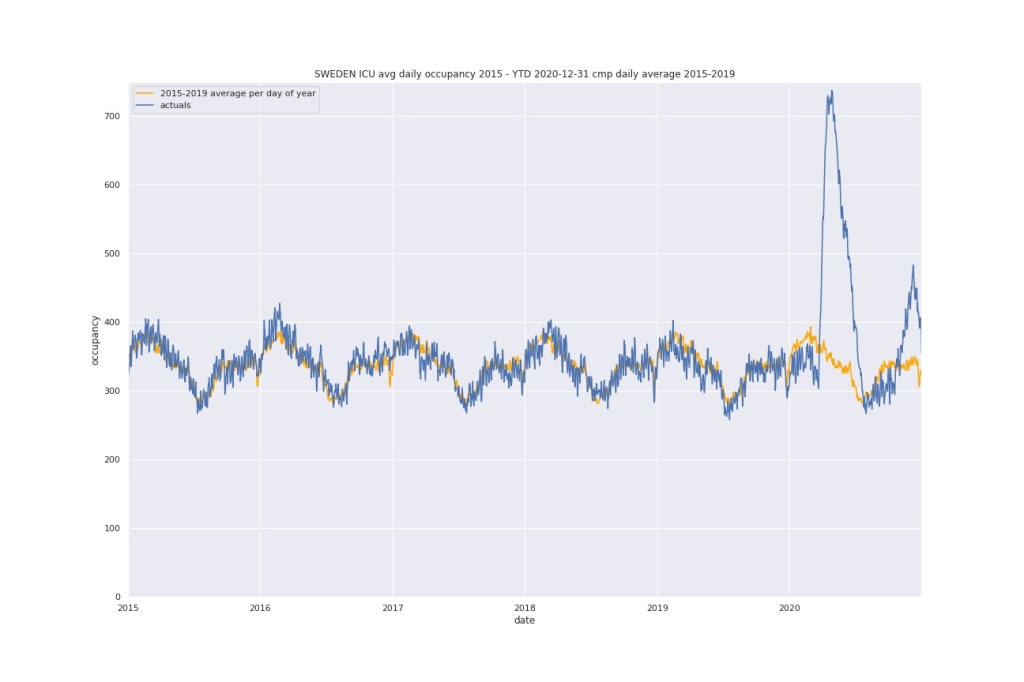
The spring Covid wave is clearly visible, with about 2x the normal number of beds needed, as is the Nov-Dec second wave, with 40% excess demand. BUT….:
Let’s have a look at the Swedish hospital capacity, in relation to the rest of the EU:
Only Lichtenstein has lower hospital capacity per capita than Sweden, at least 2018, and I doubt Swedish position has improved since then.
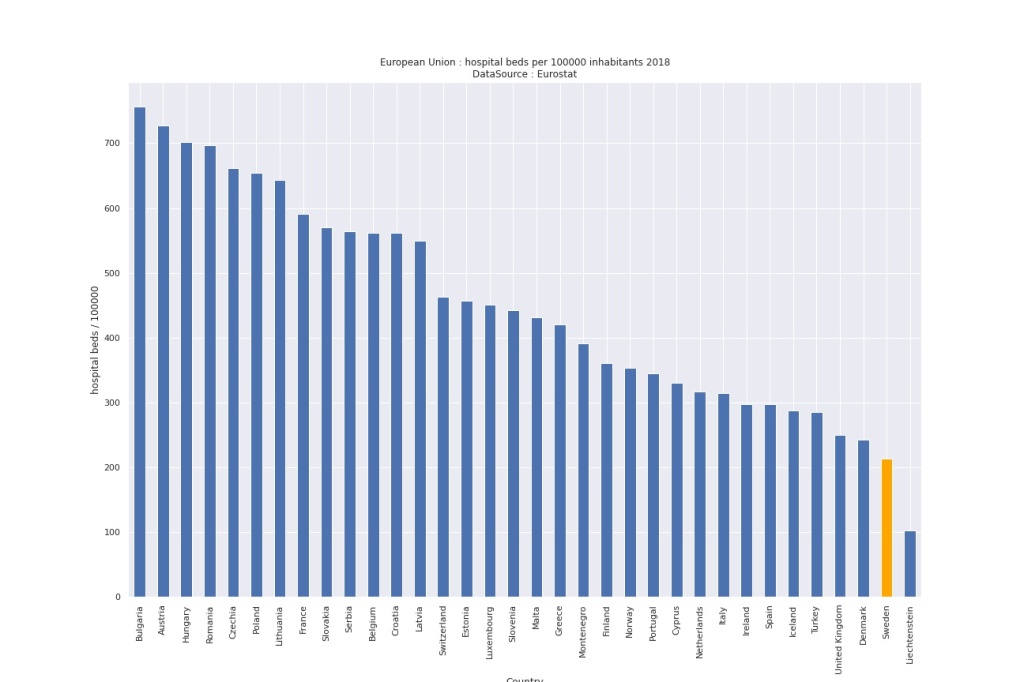
Below the trend 2007 – 2018 for Swedish hospital capacity:

Next, let’s look at the evolution of Swedish ICU beds, comparing 1993 to 2018:

ICU-capacity has gone down by a factor of 8 (!) in 25 years. So whatever emergency or crisis that would have hit Sweden, the capacity to deal with that crisis was (and is) simply not there.
No wonder the hospitals are at risk of being overwhelmed!
As a side note, here’s another example of these severe failings in crisis & contingency planning is the forrest fires of 2018, when the national fire fighting capacity was way below bar to deal with the fires. It all ended – eventually, when massive areas of forrests already had burned down, and several small towns/villages were at risk of burning down – with hundreds of Polish fire fighter coming over from Poland to clear up the mess caused by years of political mismanagement.
For more info on the forest fire’s of 2018, here’s what the Government writes in a post mortem analysis (Swedish).
The bottom line of all this is that Swedish governments since decades back have taken decision upon decision that have contributed to make the Swedish society very fragile, incapable of managing any unforeseen crisis or disaster. Let’s pray no war will break out in Sweden – if it does, we are doomed.
The high Covid death toll among our elderly, which clearly is due to decades of insufficient investments in Swedish medical care, and care of our elderly and frail, is a clear demonstration of this.
Conclusion
So, what do we make of all the above facts & figures ? Did Sweden really experience a severe deadly pandemic, a “once in 100 years flu”, with people dying in unprecedented numbers during 2020…?
A pandemic of a kind we’ve not encountered since the Spanish flu 1918…? Or did Sweden experience a severe flu with mortality about the same as past severe flu’s that tend to occur once or twice in every 20-30 years or so…?
I don’t particularly like the notion of “Excess Deaths”, since most of the time it’s impossible to know the answer to “Excess to what, exactly?”, as explained here, but below graph shows six different values for Swedish Excess Deaths 2020. They range from 7000to 1900, depending on the chosen calculation method and baseline.
Pick the number most appealing to you and your purposes.

In textual form, the Swedish “Excess Deaths” for 2020, computed by comparing “Expectation” vs outcome, with two different baselines, are then as follows:
2020 EXCESS DEATHS : Absolute excess deaths cmp baseline 15-18 : 6429 Absolute excess deaths cmp baseline 15-19 : 6978 Population adjusted excess deaths cmp baseline 15-18 : 3251 Population adjusted excess deaths cmp baseline 15-19 : 4334 Age adjusted excess deaths cmp baseline 15-18 : 1901 Age adjusted excess deaths cmp baseline 15-19 : 3146
Applying the same “Excess” computations to 2019 instead of 2020, instead of “Excess Deaths” we get a significant “Death Deficit”, regardless which calculation method or baseline we use:
2019 DEATH DEFICIT : Absolute death deficit cmp baseline 15-18 : -2745 Absolute death deficit cmp baseline 15-19 : -2196 Population adjusted death deficit cmp baseline 15-18 : -5384 Population adjusted death deficit cmp baseline 15-19 : -4307 Age adjusted death deficit cmp baseline 15-18 : -6146 Age adjusted death deficit cmp baseline 15-19 : -4916
So even if Covid never would have arrived at all during 2020, the death toll of 2020 would almost certainly been significantly higher than “normal” anyway, due to Dry Tinder-effects.
You’ll be the judge over whether the numbers above justify the “World’s Cautionary Tale” designation, or the restrictions on freedom, liberty, future and normal life that have been put in place.
My personal take on Covid 2020 in Sweden is as follows:
- Yes, Covid 2020 was real (and continues to be real at least until spring 2021, as all seasonal viruses). The number of deaths 2020 was higher than it should have been, which ever way we define “Excess”. Not exceptionally higher, and far from all the disaster scenarios painted by media, politicians and failed scientists.
- Was Covid 2020 our generation’s “Spanish Flu” ? No. Far from it, as can be seen in the graph showing 1918 above, and by comparing mortality rates, where non-age-adjusted mortality 2020 is on par with that of 2012, and age adjusted mortality 2020 on par with 2013.
- Was the Swedish Government’s response adequate ? To a large extent yes. Until they panicked and lost their mind in November 2020, and introduced “The Swedish Enabling Act“, a form of legislation that is a disgrace to any nation pretending to be democratic.
- Where “The Strategy” failed was in protecting the frail and elderly, particularly in the care homes. The strategy also failed in overall crisis & contingency planning & management, where various governments since the early 90:ies have radically reduced investments and capacity in health care, care of elderly as well as many other vital parts of the societal safety net. So, the frequently repeated “Isolate, or our hospitals will be overwhelmed!” mantra was primarily caused by several decades of catastrophic political decisions and priorities regarding medical care and other critical societal function investments and resources, as much as by the virus itself.
- What the future brings will be seen by those who survive. Myself, I’m afraid that more doom & gloom will follow for a long time in the tracks of the “2020 Covid Experience”, even if we should manage to eliminate the virus, e.g. by vaccine, during 2021. The psychological effect on populations having spent a year or more in Lockdown, thus missing most of what makes life and living worthwhile, will be interesting to observe, as will be whether social interaction patterns and behaviors eventually return to normal, or whether our future social interactions will be so deeply ingrained by Anno Covidis that we will, similar to Pavlov’s dogs, continue regarding fellow human beings as potentially deadly virus vectors.
- Similarly, as this recent article (Swedish) shows – 90000 (!) medical treatments cancelled during 2020 – we will also have to expect further “Excess Deaths” down the road, where these deaths are only indirectly caused by Covid.
This post will end my own way too long and costly focus on Covid. I will now return to topics that are more rewarding and pleasant to work on.
[A final note: in case a significant number of my readers are interested in trying to reproduce the main numbers of my analysis (nr of deaths, mortality,age adj mortality, excess deaths etc), let me know in the comments and I’ll consider providing a link to where the Python (3.8.6) and Pandas (1.1.0) script I’ve used to analyse the most important mortality data can be downloaded.]
[UPDATE : Apparently someone has made a translation of this post to Italian –
[UPDATE 2021-01-26 : While working further on this data, I discovered an anomaly regarding age group mortalities for years before 2020. They didn’t match when I compared mortalities derived from the official data vs those derived from the prel. data.
After lot’s of debugging I found the source of the difference, but didn’t understand what caused it, but after having been in touch with SCB, who were fast answering and very helpful, I learned that they for the age based prel. data, count age of death as age reached when death occurs, while the official death data I’ve used for the age group mortality rate calculations used age reached end of year.
This difference in how age is recorded resulted in the age of death from the prel.death data in some cases (those where people died before their birthday) being a year lower than the records I used, which in turn “shifts” some deaths from older – particularly the 90+ group – to younger groups. Which in turn impacted the mortality baselines I use.
In practical terms, this difference has minimal impact on the numbers (and none on the overall results/conclusions of this post), but since I put quite a lot of time & effort into “debugging” the anomaly, before finally – with the help of SCB – understanding what was going on, I thought I’d provide an update here.
Below is the updated age grp mortality chart, where the main difference cmp the previous definition of age at death is that the 90+ group now is above baseline, with previous definition of age at death it was below. As a consequence of this “shift” of age of death, the younger groups have now lower mortality cmp baseline than before.

And here’s the summary of “Excess Deaths”, calculated using the changed definition of “age at death”, also using the latest SCB weekly report death numbers from 2021-01-25:
2020 EXCESS DEATHS : Absolute excess deaths cmp baseline 15-18 : 6569 Absolute excess deaths cmp baseline 15-19 : 7118 Population adjusted excess deaths cmp baseline 15-18 : 3391 Population adjusted excess deaths cmp baseline 15-19 : 4474 Age adjusted excess deaths cmp baseline 15-18 : 1996 Age adjusted excess deaths cmp baseline 15-19 : 3248
Finally, below an “Excess Deaths” timeline 2015-2020, calculated with mortality 2015-2018 as baseline. Noteworthy in particular is 2019.



Really good article, many thanks for your work on that!
Link to code would be awesome 🙂
Fascinating. I would dearly love to see the same for Scotland and the UK…
Reblogged this on G- DOMA.
Wonderful, absolutely wonderful article. Thank you very much from Spain, the craddle of Covid madness…
thanks. Let’s hope the world regains sanity during 2021.
Did you calibrate the numbers with respect to the leap year (366 instead of 365 days)?
The average daily death count in Sweden is 250.
365 x 250 = 91250.
366 * 250 = 91500.
Pingback: Eichmann in Your Living Room – Dark Ages
Pingback: Miltä Ruotsin kokonaiskuolleisuus näyttää? – Ossi Tiihonen
Pingback: Doug Ford & Fake News, Pathological Liars – CH1.ca
Thank you for your extraordinary work here – you need a medal for this. I can only hope that the general population wake up and realise that we’ve all been led down a very dark tunnel by our truly arrogant and incompetent governments who are not fit to be in charge. Most of the problems have arisen because those governments dictating such draconian measures as lockdowns have zero understanding of proper science or statistics. Swdevperestroika – I wish you could educate them all.
thank you.
To me, the most terrifying aspect of 2020 is that it clearly shows how fragile democracy and freedom in fact is, even in countries that most of considered stable and well beyond any risk falling into totalitarianism. Humankind appears forgetting past painful lessons learned very quickly, in 2-3 generations.
Pingback: Latest News – Lockdown Sceptics
Pingback: Latest News – The Old Normal
What an extraordinary piece of work. Thank you so much. At times I’ve felt I’m going mad. The population of the UK has completely acquiesced in the removal of their rights and you begin to doubt your own sanity when you question it. To say nothing of the personal attacks you get when you speak out.
I totally agree with you that the really terrifying thing is the loss of freedom. Will we ever get it back?
I hope you are working on something more rewarding for you personally but can’t thank you enough for what you’ve done. The mathematics of it all would be beyond me but you’ve explained it very clearly. Just brilliant work.
Thank you. Yes, the personal attacks for showing the data & facts is something I’m very familiar with. One pf the lessons of 2020 for me is that civilization is a *very* thin layer upon our more primitive side.
Again, a great article.
Comments;
It seems that with Covid on can never know how it will affect you personally, so it is prudent to avoid
Long haulers – those people who suffer effects months after recuperating, again best to avoid
Under investing in health care: How do you tax people to buy resources that are not needed?
I assume what happened in the 1980’s was Chernobyl
Hard to compare results to 1918 when medical treatment has changed so much.
Thanks you, you have done very hard & important evaluations.
Hello from UK. Your article reads well to me. Thank-you – I have shared with friends.
One point – your data was able to distinguish between native and non-native born Swedes, and the latter group was hit hard. Your explanation for this turns on socio-economic factors.
I am not qualified to dispute this – for a start, I have never been to Sweden – but if I may venture a theory. In fact UK and Sweden are similar in that we have here a large number of non-white citizens, not quite 20% but, I think, about 8%. Like Sweden they tend to live in large towns and cities.
I wonder though if you have considered the issue of Vitamin-D. We know that it having high levels of it has been vital to peoples’ survival. People of colour who live in northern latitudes are known to synthesise lower levels of Vit-D, especially in winter, especially in winters in nordic countries.
Originating in Africa, Asia and the Middle-East, their dark skin evolved to protect them from the effects of the sun’s fierceness. Moving to northern latitudes meant much less sunlight, and less efficiency in synthesising Vit-D.
Might this not be a key factor in a higher death rate in people of colour in northern latitudes?
Yes, the D-vitamin aspect (or any other genetic factor) is clearly interesting. But not very politically feasible, I’m afraid… Already early stages of the pandemic, I saw a UK study where the sole group under study was medical doctors, so the assumption was that socioeconomic factors were thus controlled for – regardless of ethnicity, an MD should probably have similar socioeconomic standing – And that study found clear differences in the impact of Covid between doctors of UK origin vs doctors from non-European origin. Even when controlling for age. It would be very interesting to study that for Sweden, but unfortunately I’m not aware of any publicly available data containing both ethnicity and socioeconomic status.
Amazing article. I must observe there is something really fishy about few last weeks in Sweden. I’ve been following real time updates for Sweden since October. Everything was in order until 13th of December. At that time mortality was ticking around 89.5 thousand. Last two weeks there were additional 8 thousand deaths. That is simply not possible. Look at January of 2021. First two weeks show around 2800 deaths.
The was an expected larger than normal lag on reporting over xmas and new year which explains the increase for the last two weeks of the year.
Something is very weird happening I’m telling you. Same spike happened in my country in the last two weeks. December and January always exhibit larger lag, but not this time. These spikes are above normal. It is simply not possible that last few weeks of December have 4x death toll than first weeks of January. January is always very problematic month worldwide. Holidays are always responsible for inflammation explosion – huge contribution to respiratory diseases and cancer remissions. So it doesn’t make sense that January is so much below standard increase rate.
Check January 2017. world wide. They messed with the pool data.
Typically, the numbers on deaths do not stabilize until the 3’d week after initial report, so I wouldn’t worry too much about there for time being being a lower weekly death count Jan – 21 than for Dec-20. However, it’s clear that Dec-20 had a significantly larger proportion of yearly deaths (~ 2 pct points) (for all age grps except under 65) than normal, which is interesting.
Pingback: America Descends Into Virtual Night: It is virtual and dark, ruled by digital companies fronted by old and tired politicians – SURVIVAL BLOG
Pingback: L’Amérique s’enfonce dans la nuit virtuelle – les 7 du quebec
Pingback: Quotes for Entrepreneurs Curated in January 2021 - SKMurphy, Inc.
Pingback: La notte virtuale scende sull’America | NUTesla | The Informant
Pingback: Replying to Christopher Snowdon – Again – Lockdown Sceptics
Pingback: Zero Vegemite – Dark Ages
Pingback: Clear Messaging – Dark Ages
Pingback: The progress of the COVID-19 epidemic in Sweden: an update | Climate Etc.
Pingback: The progress of the COVID-19 epidemic in Sweden: an update – Climate- Science.press
Pingback: journal – 22Feb2021 – Dark Ages
Pingback: Covid Sweden – Final mortality based on the now Official 2020 Death Data from SCB | systems perestroika – éminence grise
Pingback: unfounded distortion = intolerable horseshit – Dark Ages
Pingback: endless cruelty – Dark Ages
Pingback: Cracking the Lunacy | alicespringstomind
Pingback: Lockdowns: Sweden was the ‘control group’ – Redline
Pingback: 2020 – האמת מאחורי ה"אסון השוודי" | אנחנו והקורונה
Wonderful work, thanks so much!
Pingback: Que restera-t-il de l’épidémiologie à la fin de la crise Covid-19 ? | Congo News
Pingback: Que Restera-t-il De L’épidémiologie à La Fin De La Crise Covid-19 ?
Pingback: Death and Lockdowns | Simply America
Pingback: Death and Lockdowns
Pingback: [NULLITÉ des modèles mathématiques pour légitimer les décisions politiques] Que restera-t-il de l’épidémiologie à la fin de la crise Covid-19 ? par Juliette ROUCHIER - Étienne Chouard - Blog du Plan C
Pingback: America Descends Into Virtual Night | Newsessentials Blog
Pingback: Dispatch from Moon Base Alpha – Dark Ages
Pingback: Be Careful What You Wish For – Dark Ages
Pingback: Lab Leak Reversal – Dark Ages
Pingback: The Pledge of Allegiance – Dark Ages
Pingback: Pausing Baby Deliveries | alicespringstomind
Pingback: Chouard.org • [NULLITÉ des modèles mathématiques pour légitimer les décisions politiques] Que restera-t-il de l’épidémiologie à la fin de la crise Covid-19 ? par Juliette ROUCHIER
Pingback: Koronapandemiassa kaikki ei täsmää - vapaasana.org
Pingback: 2020 – האמת מאחורי ה”אסון השוודי” – My Blog
Pingback: Lies about the magnitude of this pandemic – Freedom Team Australia
Pingback: Effectiveness of stay-at-home orders – A good reason
Pingback: Chouard.org • [NULLITÉ des modèles mathématiques pour légitimer les décisions politiques] Que restera-t-il de l’épidémiologie à la fin de la crise Covid-19 ? par Juliette ROUCHIER